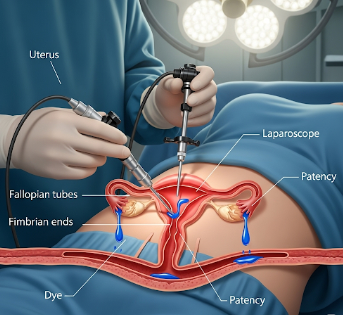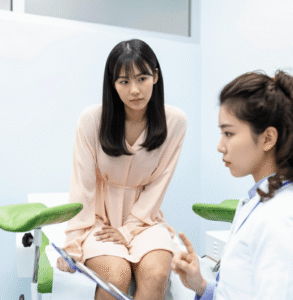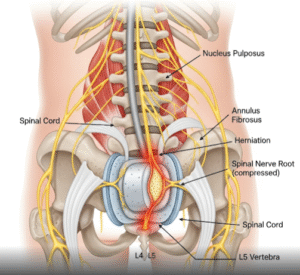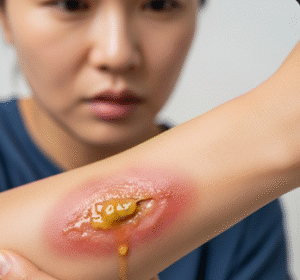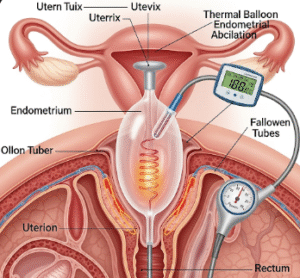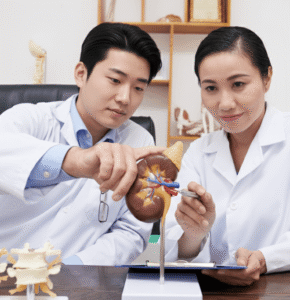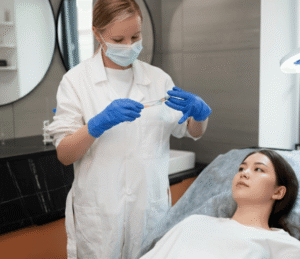Overview
Laparoscopy and Dye Test is a minimally invasive procedure performed to evaluate the female reproductive organs and the patency of the fallopian tubes, commonly used in infertility investigations. This procedure combines laparoscopy (viewing the pelvic organs via a camera inserted through a small incision) with a dye test, which helps determine if the fallopian tubes are open and functional.
In Korea, this procedure is performed by experienced gynecologic and infertility specialists using advanced laparoscopic techniques, ensuring accurate assessment, minimal pain, and rapid recovery.
Highlights:
- ✅ Evaluates uterine, ovarian, and tubal health
- ✅ Assesses fallopian tube patency for fertility planning
- ✅ Minimally invasive with short recovery time
What is Laparoscopy and Dye Test?
Laparoscopy and Dye Test involves inserting a laparoscope through a small abdominal incision to visualize the uterus, fallopian tubes, and ovaries. A colored dye (usually methylene blue or indigo carmine) is then introduced through the cervix into the uterus and fallopian tubes to check if the dye passes freely into the abdominal cavity, confirming that the tubes are open.
Indications include:
- Infertility evaluation in women
- Suspected tubal blockage
- Pelvic adhesions, endometriosis, or ovarian cysts
- Recurrent pregnancy loss potentially related to tubal issues
Important: This procedure is both diagnostic and sometimes therapeutic, as mild adhesions may be treated during laparoscopy.
What are the benefits?
- Accurate assessment of fertility: Confirms if fallopian tubes are open
- Direct visualization: Detects endometriosis, ovarian cysts, and pelvic adhesions
- Minimally invasive: Small incisions, reduced pain, and quick recovery
- Potential therapeutic benefit: Adhesions or minor abnormalities may be treated during the same procedure
Key benefits highlighted:
- ⚡ High accuracy for tubal patency and pelvic evaluation
- ⚡ Short procedure with minimal hospital stay
- ⚡ Minimal scarring and rapid recovery
- ⚡ Combines diagnostic and therapeutic intervention
Procedure Details
1) How should I prepare for Laparoscopy and Dye Test?
- Preoperative evaluation: Pelvic examination, ultrasound, blood tests, and review of medical history
- Medication review: Stop blood thinners or other medications as instructed
- Fasting: Usually 6–8 hours before surgery
- Consent and education: Discuss procedure, risks, benefits, and recovery
- Lifestyle preparation: Arrange transportation post-procedure and plan light activity for recovery
2) What happens during Laparoscopy and Dye Test?
- Anesthesia: General anesthesia administered
- Incision and port placement: 1–2 small incisions made in the abdomen for laparoscope and instruments
- Pelvic evaluation: Uterus, fallopian tubes, and ovaries examined for abnormalities
- Dye test: Colored dye introduced into the uterus and fallopian tubes; passage into the abdominal cavity is observed
- Therapeutic intervention (if needed): Mild adhesions or cysts may be treated during the same procedure
- Closure: Incisions closed with sutures or adhesive strips
Duration: Typically 30–60 minutes depending on findings and interventions
3) What happens after Laparoscopy and Dye Test?
- Recovery monitoring: Vital signs and incision sites observed
- Pain management: Mild analgesics for abdominal discomfort
- Activity: Gradual return to normal activities; avoid heavy lifting for a few days
- Follow-up care: Monitor incision healing, abdominal discomfort, and any unusual symptoms
Highlights for post-procedure care:
- ⚡ Mild cramping, shoulder tip pain, or bloating may occur
- ⚡ Small scars will heal over 1–2 weeks
- ⚡ Avoid strenuous activity for at least 1 week
- ⚡ Attend follow-up appointment to review findings and plan fertility treatment
Risks / Benefits
Risks:
- Infection at incision sites or internally
- Bleeding or hematoma
- Rare injury to surrounding organs (bladder, bowel, blood vessels)
- Anesthesia-related complications
Benefits:
- Accurate evaluation of fallopian tube patency
- Direct visualization of pelvic organs
- Potential treatment of minor pelvic abnormalities
- Minimally invasive with faster recovery
Recovery and Outlook
- Hospital stay: Usually outpatient; patient can go home the same day
- Full recovery: 1–2 weeks for most patients; mild abdominal discomfort may persist
- Long-term outlook: Excellent for fertility assessment and treatment planning
- Follow-up: Review of dye test results, discussion of fertility options, and monitoring for any postoperative complications
Tips for optimal recovery:
- ✅ Rest and avoid heavy lifting for at least 1 week
- ✅ Keep incision sites clean and dry
- ✅ Monitor for signs of infection or unusual pain
- ✅ Attend follow-up visit to discuss results and next steps
When To Call the Doctor
- Fever, chills, or signs of infection
- Severe abdominal pain or persistent cramping
- Unusual bleeding or discharge from incision sites
- Nausea, vomiting, or abdominal swelling that does not resolve
Best Korea Option / Process
Korea provides advanced laparoscopy and dye test care:
- Top hospitals: Specialized gynecology and infertility centers with expert surgeons
- Advanced diagnostics: Ultrasound, hysterosalpingography, and preoperative testing
- Minimally invasive techniques: Small incisions, high precision, and rapid recovery
- Postoperative care: Pain management, incision monitoring, and follow-up consultation
- International patient support: Online consultations, appointment scheduling, and telemedicine follow-up
Step-by-step process in Korea:
- Online consultation and preoperative assessment
- Pre-surgery preparation and fasting instructions
- Laparoscopy and dye test performed by expert gynecologic and fertility surgeons
- Postoperative monitoring, pain management, and gradual activity resumption
- Follow-up visit to review findings, assess recovery, and plan fertility treatment

